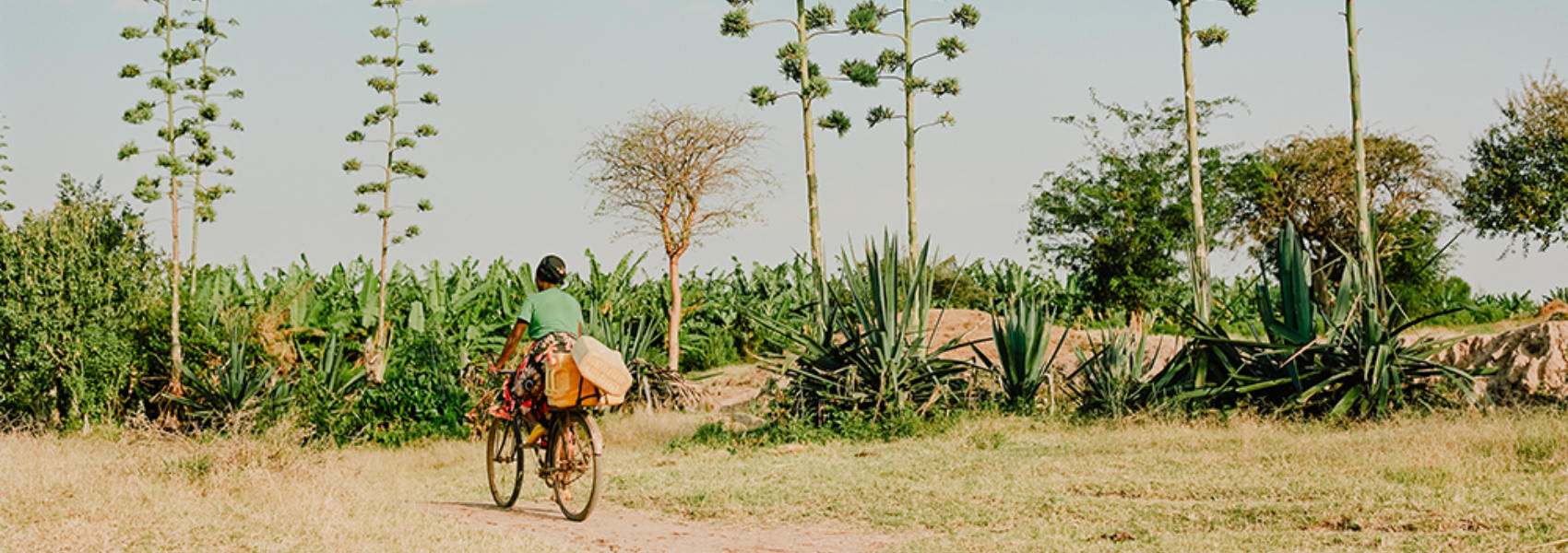
Published 29th Oct. 2025
Reading time
More people are exploring the world than ever before. We’re fortunate to live in an era when discovering different global customs and cultures is relatively easy. But it’s this very simplicity which means we need to focus extra attention on making sure we’re taking care of our planet.
We’ve all seen it – beautiful destinations (both at home and overseas) which have been damaged by the impact of one of the most invasive species on Earth: humans.
While humanity has done a lot of good, there’s no doubt that our presence can sometimes have a detrimental impact on local ecosystems and even on how people in more vulnerable areas are able to live their lives. That’s where the concept of regenerative tourism steps in.
This transformative and protective type of travel makes sure you’re giving back to the communities you’re visiting. Anyone can do it – all you need is an open mind and the knowledge of how and what it takes to see the world this way.
If you’re reading this guide, there’s a good chance you already tick off the first of those things. Now you just need the information to make sure you’re doing your part when you travel. That’s where this handy guide steps in.
From understanding what regenerative tourism looks like, to how you can make a difference, and even some of the data behind the growing popularity of this kind of travel, keep reading to learn more.
Regenerative tourism is a pioneering form of travel, which places emphasis on leaving a destination better off than when you arrived. It focuses on replacing some of the more exploitative and wasteful practices sometimes associated with tourism, with behaviours which will instead restore existing ecosystems and enhance the lives and biodiversity of the people, flora and fauna who live there.
At its core, regenerative tourism is a type of sustainable travel that helps to both preserve and positively impact the environment you’re visiting. Some common top-level examples of regenerative tourism in action might be:
- Engaging in activities led by indigenous communities
- Funding tourism projects that help revitalise local ecosystems or heritage buildings
- Rewilding and habitat restoration efforts
- Keeping the local environment clean
At their core, three of the main principles of regenerative tourism are:

Image by Olivier Romano.
If the idea of taking a regenerative holiday sounds like something which appeals to you, your next steps can be to learn how to best engage with this kind of adventure. Whether tangible actions, or even just shifts in the way you think about different parts of your travels, here are some of the most important factors to keep in mind:
- Educate yourself on the local environment. Knowledge is power. The more you know about the area you’re visiting, the better you can prepare yourself for and enhance your understanding of the place you’re choosing to engage with. To get a holistic approach, read up on or talk to local tourism boards and, if possible, indigenous groups.
- Think about the impact you’re having. Every action you take can have an impact on the world and communities around you. Think about cutting down on emissions by travelling on foot or via bike where possible. Be conscious of plastic waste and how you’re disposing of it. And always try to practice the ‘leave no trace’ mentality. That means leaving an area just as you found it (or ideally in a better condition).
- Support local businesses. Keeping money in the local community isn’t the only way to give back as a tourist – but it does have a big impact. Local businesses are the lifeblood of many tourist destinations. Helping them to flourish and grow will have a positive impact on the whole area.
- Make informed decisions about your accommodation. Some hotels can be wasteful with how they manage natural resources and rubbish. If you’re travelling with regenerative tourism in mind, you’ll want to make sure your accommodation echoes your own principles and morals. Do your research first to make sure you’re aligned.
- Think about a volunteer day. If you want to go above and beyond to give back while you travel, a volunteer day may be the perfect option. Beach or trail cleanups are some of the most popular options. These give you the chance to actively go out and have a positive impact on the local community who’ve welcomed you during your stay.

Image by Victor Stonem.
Understanding what the current regenerative tourism landscape looks like is half the battle when it comes to guaranteeing you’re doing your part. If you’d like to learn more about how this form of travel is changing the game, or want to discover some specific examples of projects in action, these 20 facts and stats are a great starting point.
1.
The appetite is clearly there for regenerative and sustainable efforts to be made as part of any trip. Reports show that as many as 43% of travellers are willing to pay more to guarantee that a trip is ethical. In a world where our wallets often speak the loudest, this is something the wider tourism sector should remain aware of.
2.
In line with that, a survey of more than 31,000 people across 34 countries would go on to highlight that 83% consider sustainability an important aspect of any holiday. 75% would say that they want to make an effort to travel more regeneratively and sustainably over the next year, while 43% went as far as to say they’d even feel guilty if they travelled without making environmentally friendly choices.

Image by Faustine Poidevin-Gros.
3.
As we’ve discussed, money is not at the heart of the regenerative tourism movement. However, it does nonetheless have a big impact in how seriously some companies might take this novel concept. It’s encouraging news then that the regenerative tourism sector as a whole is believed to be worth a staggering $2.5 trillion – and it’s estimated that this could double by the end of 2030. While numbers like this always need to be taken with a pinch of salt, it underlines the sheer scale and rapid increase in popularity of these kinds of holidays.
4.
Despite the positive numbers, some people are still not convinced. Regenerative tourism is very much still in its infancy. In 2025, those who engage in it are still considered early adopters. As such, some investors cite a lack of existing data or even wider market confidence as a reason not to fully embrace this movement. 58% of those in a recent survey placed themselves in this bracket.

Image by Olivier Romano.
5.
But don’t let those figures discourage you too much. The fact of the matter is that the appetite is very much there from a lot of holidaymakers and service providers alike. While the numbers are still far from where some would want them to be, as many as 20% of hospitality leaders are now implementing regenerative tourism in some capacity.
6.
And with such strong sentiment from their clientele, it’s not hard to see why an increasing number of service providers are shifting their approach. A very healthy 66% of all travellers have been reported as not only wanting to protect the environments they’re visiting, but actively taking steps to leave them in better conditions than they found them. This desire to nurture and improve communities and green areas is rooted at the core of the regenerative travel movement.

Image by Olivier Romano.
7.
At the frontline of this goal to be cleaner and greener is the desire to cut back on plastic waste. It’s no longer a secret just how much of a negative impact non-degradable plastics can have on the world around us. 87% of holidaymakers surveyed said that this was at the forefront of their efforts to be more mindful and sustainable when they explore a new environment.
8.
Supporting local businesses is also a concept which has seen far greater adoption in recent years. 58% of travellers said they would be more likely to support brands that collaborate with local communities (both at home and while they travel). This is all part of their desire to get an authentic insight into the way communities live and operate, while also helping to actively give back and see them thrive.

Image by Jérôme Galland.
9.
One of the most telling shifts in habits comes in the types of holiday that people are looking to engage with. That extends beyond just the activities they choose, but also factors in the kinds of accommodation they’re looking to stay in. AirBnb reported a 23% growth in rural lodgings in 2025, as more people look to get out and immerse themselves more in the natural world while they travel.
10.
The ultimate aim of regenerative tourism is to give back to and protect existing ecosystems and local communities. This goal helps to support the UN’s Decade on Ecosystem Restoration project, whose aspirations parallel that of regenerative tourists. In encouraging news, global wildlife tourism is thought to generate more than five times as much money as the illegal wildlife trade. While we’d all love to see that gulf grow even wider, it’s a good starting point.

Image by Berend Leupen / Unsplash.
11.
For those wanting to know how they can do their part to help the UN as they strive towards the sustainability targets, you’re in luck. Their official website catalogues all 17 of their core goals, giving you the chance to understand and try to align your next travel opportunity with one, or a handful of their goals.
12.
An example of a regenerative travel opportunity is a trip to the Italian coastal towns of Acciaroli and Pioppi. These Blue Flag beaches have made a commitment to keeping waters clean, tourism at responsible and sustainable levels, and ensuring that the local ecosystem is kept in balance. Acciaroli and Pioppi offer visitors the chance to learn traditional menaica fishing, which serves as the perfect way to engage with the local culture constructively and with minimal impact.

Image by maurizio siani
13.
In the same region, the Cammino delle Terre della Dieta Mediterranea (‘Path of the Lands of the Mediterranean Diet’) is an 87-and-a-half-mile stretch of land which visitors can travel along and sample different local culinary delights from a number of charming Cilento towns and villages along the way. Highlights include stops at locations like Poseidonia, Paestum, Elea and Velia.
14.
The capital city of Iceland is another spot which is incredibly popular among regenerative tourists. Reykjavik uses geothermal energy to provide a carbon-neutral holiday experience for visitors, while a number of restoration and other ethical projects are available to engage with. Tourists can visit Hliðar to experience urban farming or community gardens and support local produce if available. Friðheimar is another fantastic day trip. This geothermal greenhouse grows tomatoes, and allows guests to dine at their restaurant, where the produce is locally sourced.

Image by Henry Middleditch / Getty Images.
15.
The popular villages of Laos are also using their allure to help give back to and protect local communities. Some highlights on a holiday here might be to visit the Living Crafts Centre in Luang Prabang, where you can take weaving & natural dye workshops. The Feuang District, including Ban Namai & Ban Sammeun Villages, is also worth checking out. You can take workshops, river tours and buy plenty of souvenirs directly from local craftspeople.
16.
This Indonesian island has been at the forefront of regenerative tourism in the region, with visitors able to immerse themselves in a number of traditional activities and customs, all while staying in authentic and eco-friendly accommodation which is tied to Indonesian heritage. Visit villages like Kampung Letehakapuna and Kampung Liling to get firsthand weaving lessons, or head to Tebara to observe and maybe even participate in traditional dances or rituals.

Image by Pie Aerts.
17.
French Polynesia is home to a number of local artisans who offer farm tours all across Bora Bora. All proceeds from tours go back into the pockets of the locals. Once you’re done, also make sure to check out Wood Carving and Pareo Painting workshops, as well as a number of cultural tours which give you the storied history of the idyllic corner of the world.
18.
Rome is far from a hidden gem, but the need to protect this cultural giant has never been greater. Thankfully, there are plenty of ways you can give back to the community, as well as projects which serve to protect some of the city’s most famous monuments. Aside from a number of local heritage tours and workshops (focused on ceramics, home crafts and ancient techniques), you can also join immersive experiences such as an artisan’s retreat in Latium, or a walking tour of Monteverde.

Image by Pauline Chardin.
19.
For nature lovers, a trip to at least one of the 63 national parks found across the US is a must in your lifetime. These parks are at the epicentre of everything the regenerative travel revolution represents. With a focus on conserving the lives and environments of both flora and fauna, these parks serve as fantastic ways to foster and support restoration efforts, support conservation through guidance tours and your cost of admission, and develop a deep understanding and appreciation for the cultures and ecosystems which once (or still) call these natural havens home.
So, you’ve decided regenerative tourism is the right choice for you. That’s amazing. Adopting this progressive approach to travel is going to have a huge impact on local communities and ecosystems – and that’s something you can be proud of.
But what does the future hold for this pioneering style of travel? While nobody can know for sure, here are some trends which are defining what the next decade of regenerative travel might look like.
- Tackling food waste. More destinations are now growing their own organic food as part of the experience. This helps to bolster local communities, while also reducing carbon emissions for any food that needs to be exported. This reliance on local farmers will hopefully also help to lower ‘plate waste’, meaning less food is thrown away as it doesn’t spoil as fast.
- Nature-based experiences. Travel that encourages active involvement with nature, such as eco-lodges, conservation volunteering and wildlife encounters are seeing a rapid rise in popularity. As more people begin to prioritise these kinds of authentic and environmentally conscious experiences, expect to see trips specifically tailored to nature.
- Technological advances. While it might not be something which immediately springs to mind when you think about regenerative travel, the rapid and vast technological advancements which we continue to see adopted across the world can also have a positive impact on this kind of holiday. Just some of the ways we’re already seeing this in practice are:
- Smart grids to manage and store energy
- Waste management technologies with advanced recycling systems
- Blockchains to make sure fair trade practices are followed, as well as tracking the origin of all locally sourced products
- Virtual reality and augmented reality experiences to educate travellers about different destinations
The use of these kinds of tech might not feel particularly ‘green’, but the informed decision-making they allow both guests and hosts, as well as their ability to drive sustainable choices, is going to continue to have a huge impact on the regenerative tourism industry.
If it’s within your power, taking a regenerative approach to travel can help to give back to the destinations which made your trip so wonderful to begin with. If you’d like to learn more about this kind of travel, as well as the countless locations which offer this sort of excursion, be sure to reach out to our team for more info. We look forward to kickstarting your more sustainable way to travel today.

Image by Olivier Romano.
Header image by Pie Aerts.
Practical advice and inspiration for your next trip

There’s more to Tunisia holidays than blissful beaches. History buffs are in luck with plenty of UNESCO World Heritage sites to explore, while architecture enthusiasts can admire the coastal towns’ white-washed facades. If natural wonders are more up your alley, Tunisia’s vast salt flats and towering palm groves are a must-see, while the artisanal treasures in the Medina of Tunis await those on a souvenir search.
9th December 2025 - Tunisia Travel Inspiration

When it comes to romance, Greece’s islands set the bar high. From Paros’ sun-kissed beaches and Folegandros’ blush-pink blooms to Sifnos’ culinary delights and Hydra’s slow-paced streets, each island radiates beauty. Whether you fall in love with the sunset in Santorini or the atmosphere in Apollonia, the perfect spot awaits. Read on to discover the most romantic islands in Greece... Paros Folegandros Sifnos Hydra Santorini Paros Best for:
27th October 2025 - Greece Travel Inspiration

When it comes to postcard-perfect beaches, the USA has them in bucket-(and spade)-load. From California’s colourful coast and Florida’s buzzing beaches to Oregon’s rugged shores and Georgia’s photogenic stretches, there’s no shortage of sandy escapes on a USA holiday. Spot puffins on Cannon Beach and nesting turtles on Perdido Key, or stroll past Art Deco architecture on South Beach and charming hotels overlooking Coronado Beach.
4th August 2025 - USA Beaches & Islands

Our team of destination experts will get to know you and your unique requirements for your holiday

We work with you to build an ultra-personalised holiday itinerary with your choice of accommodation, experiences and activities

All of our holidays include little extras designed to make a big difference to your trip, from fast-tracking you through airport check-in and security to our network of local Concierges